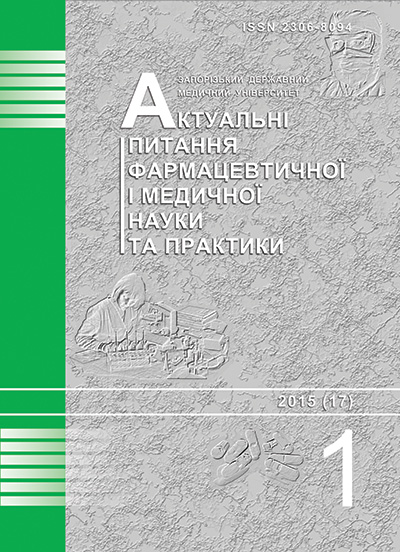SPECTROPHOTOMETRIC DETERMINATION OF ACETYLCYSTEINE IN PHARMACEUTICAL FORMULATIONS USING 2,3-DICHLORO-1,4-NAPTHOQUINONE
DOI:
https://doi.org/10.14739/2409-2932.2015.1.41374Keywords:
Spectrophotometry, Acetylcysteine, 2, 3-dichloro-1, 4-napthoquinone, Analysis, Validation StudiesAbstract
The aim of research was the development and validation ofspectrophotometric method foracetylcysteine assay in pharmaceutical formulations.Тhe proposed method is based on the reaction with 2,3-dichloro-1,4-naphthoquinone and the formation of colored products that exhibit absorption maxima at 425 nm.
Introduction
Many analytical methods have been published for acetylcysteine assay in pharmaceutical formulations as high-performance liquid chromatography (HPLC), fluorimetry and chemiluminescence. Some of these methods are time consuming or require expensive equipment. Other published methods suffer from lack of selectivity and sensitivity. Spectrophotometry is the most widely used technique in pharmaceutical analysis because it is simple, economic, and easily available to most quality control laboratories.
In the present work, we propose a simple and accurate spectrophotometric method for acetylcysteine assay in pharmaceutical formulations.
Materials and Methods
Reagents: Reference standard acetylcysteinesubstance; 2,3-dichloro-1,4-naphthoquinone. All chemicals and solvents were of analytical grade.
DMFA was used as a solvent.
Pharmaceutical preparations:powder for oral solution «ACC 200» 200 mgseries number50026151 (Salutas Pharma CmbH, Germany); effervescent tablets «Fluimucil» 600 mg (Zambon S.P.A., Italy) and «ACC LONG» 600 mg (Salutas Pharma CmbH, Germany) series numbers 321284 and DH2740; solution for injections «Fluimucil» 100 mg/ml (Zambon S.P.A., Italy)series number28002492.
Solutions:
- Acetylcysteine stock solution (0,16%);
- DMFAsolution of 2,3-dichloro-1,4-naphthoquinone (4%).
Equipment
Analytical balance (ABT-120-5DM); UV-VIS spectrophotometer (Specord 200); water bath (MemmertWNB 7-45);quartz cells.
Results
Acetylcysteine was determined using a spectrophotometric method based on the reaction with 2,3-dichloro-1,4-naphthoquinone to form yellow colored reaction products with absorption maxima at 425 nm. The effect of reaction time and temperature was studied. It was found that the reaction requires heating at 95°С for 10 min.
The proposed method is valid according to the validation requirements of Ukrainian Pharmacopeia. The following parameters were considered: range of application, linearity, accuracy, robustness, precision of the results.
Conclusion
The proposed spectrophotometric method for quantitative determination of acetylcysteine in pharmaceutical formulations was found to be simple, precise, accurate, linear, robust and rugged during validation. Further this method can be recommended for routine quantitative determination of the studied drugs in quality control laboratories.
References
Mashkovskij, M. D. (2012). Lekarstvennye sredstva [Drugs]. Moscow: Novaya Volna. [in Russian].
Simonova, O. I., & Gorinova, O. I. (2014). Primenenie acetiltsisteina dlya lecheniya respiratornyikh zabolevaniy u detej mladshego vozrasta [The use of acetylcysteine for the treatment of respiratory diseases in young children]. Farmateka, 1(274), 87–90.
Kukoc-Modun, L., & Radić, N. (2011). Spectrophotometric determination of N-Acetyl-L-Cysteine and N-(2-Mercaptopropionyl)-Glycine in pharmaceutical preparations. International Journal of Analytical Chemistry, 2011, 1–6. doi: 10.1155/2011/140756.
Taha, E., Hassan, N., Aal, F., & Fattah, L. (2007). Fluorimetric determination of some sulfur containing compounds through complex formation with Terbium (Tb+3) and Uranium (U+3). Journal of Fluorescence, 17(3), 293–300. doi: 10.1007/s10895-007-0172-6.
Li, H., & Du, J. (2009). Sensitive chemiluminescence determination of three thiol compounds based on Cu(II)-catalyzing luminol reaction in the absence of an oxidant. Analytical Letters, 42(13), 2131–2140. doi: 10.1080/00032710903082754.
Jyothi, N., & Pasha, S. (2014). Development and validation of a new RP-HPLC method for simultaneous estimation of N-Acetylcysteine and L-Arginine in combined dosage form. Oriental Journal of Chememistry, 30(3), 1371–1378.
Sana, S., Rajani, A., Sumedha, N., Pravin, P., & Shripad, N. (2012). Development and validation of RP-HPLC method for the estimation of N-Acetylcysteine in wet cough syrup. International Journal of Drug Development & Research, 4(2), 284–293.
(2009). British Pharmacopeia. London: The Stationary Office, 109–113.
(2013). United States Pharmacopeia. Rockville: USP Convention Inc., 2334.
(2007). European Pharmacopoeia. Strasbourg: Сouncil of Europe, 1100.
(2008). Derzhavna farmakopeia Ukrainy. Dopovnennia 2. [Ukrainian Pharmacopoeia. Addition 2]. Kharkiv: Naukovo-ekspertniy farmakopeyniy tsentr. [in Ukrainian].
Downloads
How to Cite
Issue
Section
License
Authors who publish with this journal retain copyright and grant the journal right of first publication with the work simultaneously licensed under a Creative Commons Attribution License that allows others to share the work with an acknowledgement of the work's authorship and initial publication in this journal.


